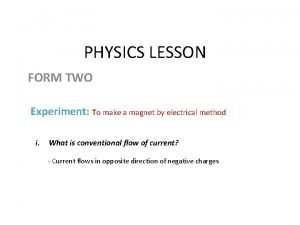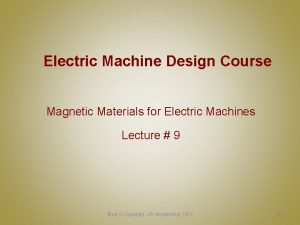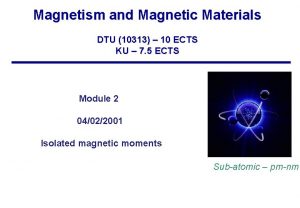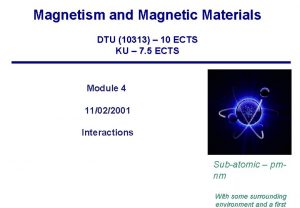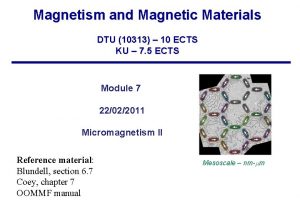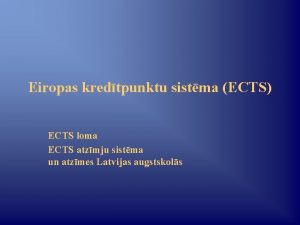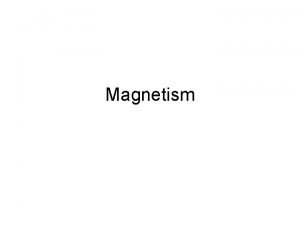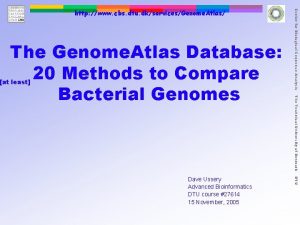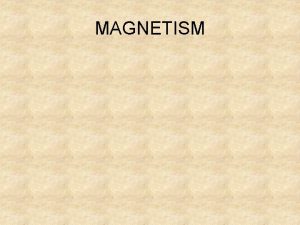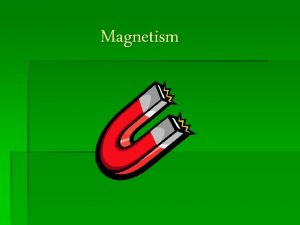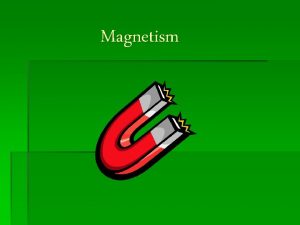Magnetism and Magnetic Materials DTU 10313 10 ECTS
















- Slides: 16

Magnetism and Magnetic Materials DTU (10313) – 10 ECTS KU – 7. 5 ECTS Module 6 18/02/2011 Micromagnetism I Reference material: Blundell, section 6. 7 Coey, chapter 7 These lecture notes Mesoscale – nm-mm

Intended Learning Outcomes (ILO) (for today’s module) 1. 2. 3. 4. 5. 6. Explain why and how magnetic domains form Estimate the domain wall width Calculate demagnetizing fields in simple geometries Describe superparamagnetism in simple terms List Brown’s equation in micromagnetics Explain how hysteresis arises in a simple Stoner-Wolfharth model

Flashback

Edge effects and consequences This is a bit misleading

Dipoles Dipole field Two interacting dipoles Dipole vector potential m 2 H 1 2 Dipolar energy Zeeman energy Torque H 2 1 m 1

Energy of magnetized bodies This is to avoid double-counting Each dipole (magnetic moment) within a magnetized body interacts with each and every other. The sum of all that is the “self energy” of a magnetized body. dm 2 dm 1 Recognize this? It’s the dipole field “density”. The demagnetization field

The demagnetization field For spheres, ellipsoids, and a few other shapes, the demag field is uniform throughout the shape. In general, the demag field is highly non-uniform. = B + M H

Demag field for uniformly magnetized objects Introducing the characteristic function D(r), with value 1 inside the object, and 0 outside, we disentangle shape effects and get a convenient expression for the demag field. Representation of the demag field for a uniformly magnetized tetrahedron

Demag energy and demag factors Demag field as a result of a tensor operation on the magnetization Nz Ny Nx The demag tensor (a function of position) The demag energy: a 2 -form involving the three demag factors along main axes and the magnetization direction cosines Demag factors This is valid for any shape, provided its magnetization is uniform.

Domain walls Large dipolar energy, no exchange energy Snaller dipolar energy, some exchange energy Idem Bloch walls: bulk, thick objects Neel walls: thin films, thin objects Cross-over between dipolar and domain wall energies for a sphere (idealized model)

Wall width The strong commercial magnet Nd. Fe. B has K=4. 3 e 6 J/m 3, and A=7. 3 e-12 J/m. Estimate the domain wall width in this material. The domain wall energy is proportional to the area

Magnetocrystalline anisotropy The crystal structure creates anisotropy: some directions are more responsive (“easier to magnetize”) to applied fields than others. Uniaxial Cubic u M Consider a sphere of radius R magnetized along some easy axis u with anisotropy constant Ku=4. 53 e 5 J/m 3 (value for Co). If the magnetization flips to –u, the energy remains the same (up and down states are degenerate). But, in order to rotate from +u to –u, the magnetization has to go through a high energy state, i. e. when M points perpendicular to u. Suppose that the temperature is such that k. BT is of the same order of the energy barrier separating the degenerate states. What happens?

Stoner-Wolfharth The direction of M at any given applied field y M H x Single-domain hysteresis is a consequence of anisotropy (shape or magnetocrystalline).

Brown’s equations The whole set of equations provides a full description of the energy landscape of a micromagnetic system (such as the one shown above) and drives its evolution towards the ground state of minimum energy

Sneak peek Searching for ground states Micromagnetic simulations Magnetodynamics and evolution LLG equation

Wrapping up • Magnetic domains • Bloch and Neel walls, and wall widths • Dipolar/magnetostatic/demag energy • Demagnetization fields and factors • Stoner-Wolfharth hysteresis • Magnetocrystalline anisotropy • Brown’s equations Please remember to: • Install OOMMF on your laptop • Familiarize a little bit with it • Bring your laptop to class on Tuesday, February 22 Next lecture: Tuesday February 22, 13: 15, KU (A 9) Micromagnetism II (MB)
 Conceptual physics magnetism
Conceptual physics magnetism Ects grade
Ects grade Ects
Ects Ects credits nedir
Ects credits nedir Edukacja cl
Edukacja cl Conversione voti ects in trentesimi
Conversione voti ects in trentesimi Utcn orar
Utcn orar Datamatiker uddannelse næstved
Datamatiker uddannelse næstved Coercivity
Coercivity Flux unit weber
Flux unit weber Magnetic moment and magnetic field relation
Magnetic moment and magnetic field relation Magnetic force particle
Magnetic force particle Distinguish between magnetic and nonmagnetic materials
Distinguish between magnetic and nonmagnetic materials Distinguish between magnetic and nonmagnetic materials
Distinguish between magnetic and nonmagnetic materials Magnetic materials used in electrical machines
Magnetic materials used in electrical machines What is magnet
What is magnet Cant stop the feeling go noodle
Cant stop the feeling go noodle












